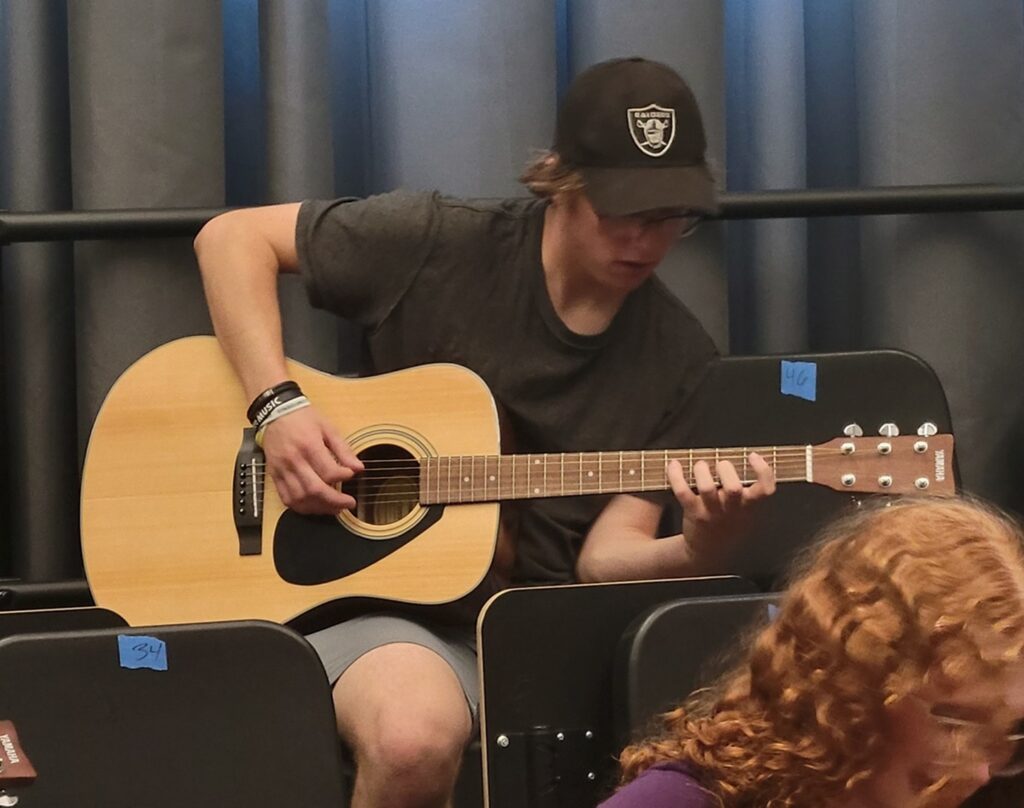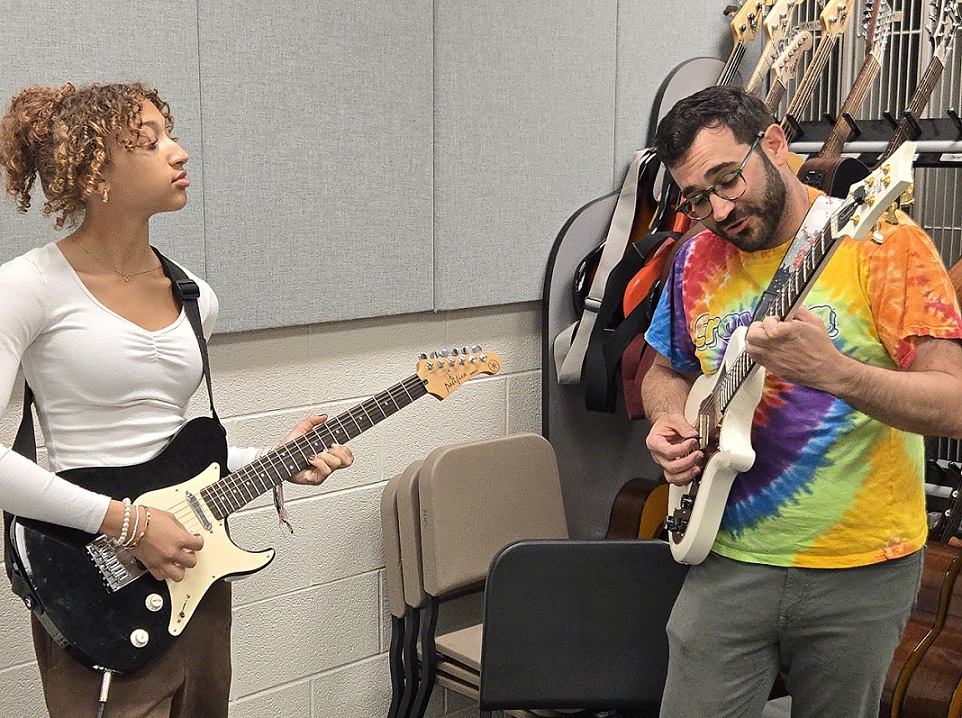Why Teach the Blues?
Guitar students can learn to solo confidently by learning and understanding the language, style and form of the blues.
What do guitar solos from Queen, Muse, Jimi Hendrix, Led Zeppelin, DragonForce, Metallica, Dream Theater, Weezer and 99.9% of other bands have in common? They all incorporate elements of the blues. Guitarists frequently use blues language in their solos. This isn’t something reserved solely for professionals — learning how to play the blues is the best way to start teaching students how to solo on guitar.
This is how I introduce soloing to students. I have them find songs that have guitar solos that they like. Then, we listen to them as a class, and I call out elements of blues style that I hear —bending, sliding, double stops (playing more than one note at a time), hammer-ons and pulls-offs, and vibrato. After we have listened to all the solos, it’s clear to the students that each solo has at least one element of blues style. I tell my students that if they learn how to play the blues, they are learning the building blocks of soloing in every style.
Blues History and Listening
It’s important to discuss the origins of the blues; students must have respect and reverence to the culture. Students are assigned to read the article, “A Brief History of the Blues,” and then the class discusses where the blues came from.
The best way to learn a new language is through immersion, surrounding yourself with people who speak it natively. The same principle applies to learning a new musical language. If you want to learn the sound of Bach, listen to nothing but Bach. If you want to play the blues, listen to the blues! The goal is to fully understand the style and its important players. By immersing yourself in the style of a particular artist and learning some of their licks, you will eventually be able to imitate their playing.
When I teach the blues, we listen all the time. I play the significant voices — B.B. King, Stevie Ray Vaughan, Albert King, Buddy Guy, T-Bone Walker — and more modern players like Joe Bonamassa, Kirk Fletcher and Josh Smith. We compare their tones and playing styles, listening for similarities in their vocabulary. For example, there is a clear lineage from T-Bone Walker, Albert King, Stevie Ray Vaughan to Josh Smith. You can tell that these musicians learned the blues language by listening to the greats of their time and developed their styles by expanding on what they heard.
With enough listening, students can identify who they are listening to based on their tone and playing style. Here are some playlists for early blues, classic artists, jazz blues and modern players.
Learning the Form
The blues is both a song form and a style. Its form has many variations, but most are 12 measures in length, separated into three four-measure phrases, and centered around the I, IV and V chords in a given key. Blues as a style involves interpreting a melody by adding bends, slides and other stylistic ornaments.
To understand the form of the blues, I have students listen to recordings of blues masters or to a blues backing track in A that I created. I ask them to clap when they hear the beginning of a new chorus. They usually intuitively feel the end of the 12-bar phrase and rarely need help counting it out. Once they can identify the beginning of the form, I pause the recording and ask students what measure I’m on. This helps them recognize larger phrases and develop an understanding of where they are in the form.
Here is a page on learning blues form.
Bass
After that, I show students a lead sheet of the blues form using Roman numerals. They say the numbers of the blues when the chords change in a recording. Then, we play the root notes along with a backing track in A to create a one-note bass line. With enough practice, they can play the bass roots without needing the backing track. If your students are comfortable with power chords, they can play the 1-6-5-6 bass line to the blues form. This is a fun and easy bass line to play, especially because it centers around the power chord shape.
Here is a page on learning blues bass.
Chords
Students can play power chords along with a blues in A to further their mastery of feeling the blues form. They can play these chords in quarter notes or swung eighth notes. Just like the bass lines, students can add the 6th to their power chord shape on beats two and four to play a “Sweet Home Chicago” style blues shuffle.
Here is a page on learning blues chords.
Language
Once students can hear the form of a blues and play a simple bass line and power chords, they are ready to start learning some language. I begin with call-and-repeat exercises such as one note played rhythmically with style and then I gradually add more notes to create simple phrases. Focus on having students copy not only the notes and rhythms, but also the articulation and dynamics — this is where the soul of the music lies.
Have students learn a lick and then record themselves and listen back to it. The goal is to make their performance sound as close to the original as possible. I also provide a lick library where students can listen to single licks played at two tempos and receive explanations of how the lick works. Let their curiosity guide which licks they want to learn. Some students will stick to easier ones, while others will seek out more advance-sounding licks because they enjoy the sound — which is super cool! Students can continue this study by finding licks in recordings and learn them by ear.
Here is a page with another call-and-response video and the lick library.
A Note on Using Scales to Solo: Some have tried teaching soloing using the blues scales. I think of scales as letters that can be used to create words. Without context, beginning improvisers often put the letters together to form words that make no sense. Moreover, it’s not just the notes that are played that tell a story through a solo, but how and when they are played. Often, when students solo with the blues scale, their playing lacks intention. Introducing licks through call-and-repeat activities allows students to not only learn notes that sound good over the blues but also allows them to understand how and when to play these notes to create words and phrases that tell their story.
Creating a Narrative
The best solos tell a story. There is a beginning, a middle and an end that takes the listener on a journey. It takes years of practice to improvise a solo like this. Often, professional guitarists have a rough idea of where their solo is going before they start. Some professionals even play the same or very similar solo in the same song.
To slow down the process, have students write a solo narrative outside of musical time. They can start by deciding how many choruses of the blues the solo will last. Then, they can write down the order of the licks that will be played. Beginning students often resist repeating licks in a solo, but that’s exactly what makes a solo memorable. They can write down ways to link licks together and plan how to develop dynamics, contrast and build energy over time. This is analogous to brainstorming and writing a short story instead of creating one on the spot. This exercise removes the fear of soloing and gives students an opportunity to feel confident about what they play.
After students have written and played a few solos, they can start to script improvised sections into their narrative, allowing them to freely create using the language they have assimilated into their playing.
The Jam
Now that students know the blues form, they can play a simple bass line, comp with basic chords and execute a planned-out solo using authentic blues language. This enables them to engage in one of the most transcendent activities musicians can partake in: jamming.
Put students into groups of three and have them take turns playing chords, bass and soloing. The group can come up with a band name, and each member can create a stage name. Allow them time to play the different rhythm section roles together with a drum backing track initially so they become comfortable keeping the form while playing in a group.
The first thing most students lose when jamming is the form, so it’s a good idea to let them know that the best way to get back into the form is to take a moment to listen to the other players. They can even help each other by indicating what measure is coming up. One thing they shouldn’t do is stop playing because this disrupts the flow and is a big no-no in the performing world.
Try It!
Since I started teaching the blues, I no longer worry about students taking solos that lacked intention or believability. The practice they receive from learning the language authentically translates to every other style of single-note playing. I used to force students to solo, and only those who had taken lessons before would volunteer. Now, I have students jamming with each other before school, after school and during resource periods. They are meeting on weekends and playing in each other’s garages and basements — it has really changed the culture of the guitar program at our school!
On my site, ShedtheMusic, I offer a Blues Teacher Guide. I hope this guide will help you as explore the best way to teach the blues to your students.















